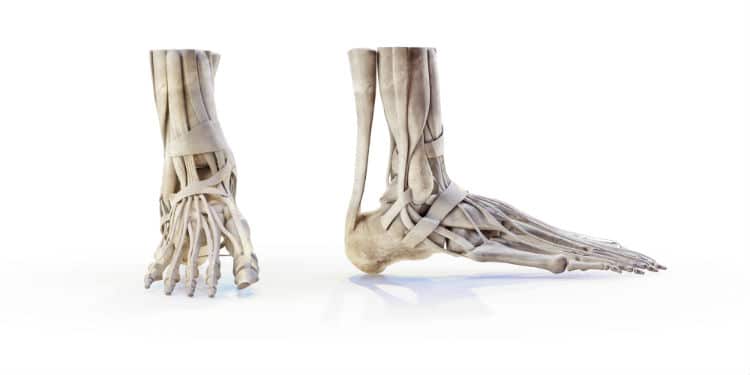How Your Foot Structure May Be Making You Fall Apart
Often times we don’t realize how complicated and complex our feet actually are. To put it in perspective, our feet and ankles are home to a total of 52 bones, 66 joints, and hundreds of muscles, tendons, ligaments, and nerves. And, all of these different structures work together every day to get you from here to there, all free of charge!
Shouldn’t we start paying more attention our feet?
The simple answer is: yes! Regardless of your lifestyle, age, and other factors, many of us experience foot problems at some point in our lives. All the twists and turns, the minor misalignments, and the unwanted weight gains are just a few of the many things that can add unnecessary stress to your feet.
And, although you may think that there is no reason to be concerned, these issues can cause you to walk in biomechanically inefficient ways (bad, or flawed biomechanics) and even limit your body’s mobility. Not to mention that pain in your feet and ankles can also trickle up toward your lower legs, knees, hip, and even back area.
It is time to stop taking our feet for granted!
In podiatry, biomechanics are studied to determine the movement of the ankle, toes, and the foot, as well as the force impacts they endure. Through a biomechanical evaluation, our experts here at Southern California Foot & Ankle Specialists can successfully diagnose and treat conditions that may be affecting your everyday movements.
This means we can not only correct foot problems, but also foresee any problems which may happen in the future due to any present abnormalities. After all, an ounce of prevention is better than a pound of cure, right?
Keep reading to find out more about this topic and how we can evaluate your biomechanics.
The History of Biomechanics
Essentially, biomechanics evaluation allows podiatrists to get a better understanding of our feet and how they actually work.
The study of biomechanics goes back to ancient Egypt at around 3000 B.C. – this is when the first evidence of professional foot care has been recorded. Throughout the following centuries, advancements in technology and science have led to today’s more accurate diagnoses of conditions like bunions and corns. And, as technology improved, so did the corrective methods that allow us to fix abnormalities in our natural biomechanics.
Computers are now able to provide precise readings of the forces, movements, and patterns of our feet and lower legs. And, today, much-needed treatment options can be provided to patients who suffer from foot problems that cause their biomechanics to be flawed.
Understanding foot biomechanics through evaluation can help improve movement and altogether eliminate pain. So, you should speak with a podiatrist if you have been experiencing any foot problems. With the exact cause known, we can offer you a number of easy solutions, such as wearing orthotics, keeping excess pressure off the foot, and other methods to treat your specific condition.
What Does “Bad Biomechanics” Mean?
Whenever you take a step, your feet go through a process called the gait cycle. This happens when you bring one foot forward and plant your heel on the ground followed by the rest of your foot.
As you apply you weight to your foot, the arch flattens just enough to support your body without enduring as much impact. Your foot then rolls slightly inward as the heel finally comes up and you push off with your toes.
This is the short version of explaining what taking a step should look like.
Unfortunately, your own walking gait can deviate from this ideal model. For example, your feet may roll a little too far inward as you load weight onto your feet – this is called overpronation. This seemingly small abnormality can place enormous additional stress on muscles, tendons, ligaments, and joints throughout your entire foot, lower leg, and even your knees.
That is what we call bad, or flawed, biomechanics. And it can very well become a contributing factor in the development of a diverse range of conditions, including:
- Heel pain
- Ankle sprains
- Sports injuries (shin splints, stress fractures, Achilles tendinitis, etc.)
- Pinched nerves
- Bunions
How Biomechanical Evaluations Can Help You
Because bad biomechanics are a significant contributing factor in many painful conditions, biomechanical evaluation is often an important aspect of diagnosing your foot-related problem. To do so, we will watch you – and even videotape you – as you walk and run. We may also measure other components of your gait like your stride length and leg length differential.
Here are some things with which biomechanical evaluation can help us:
- Correlating a clinical diagnosis with an underlying cause. Establishing why your feet hurt or why your bunion is getting progressively worse helps us offer the most effective treatment solution for your situation.
- Crafting effective custom orthotics. Orthotics aren’t just there to provide cushioning or arch support. Some orthotics made from rigid or semi-rigid materials are actually designed to correct biomechanical abnormalities like overpronation, under-pronation, weak ankles, and more. Biomechanical evaluation helps us determine what type of orthotic device would provide the greatest benefit to you.
- Planning for surgery. When planning a reconstructive surgery or other more aggressive treatment for pain or deformity, a biomechanical evaluation can provide important information about which procedures will be the safest to perform or will be most beneficial.
Contact Us Today
So, if you or someone you love has been suffering from foot pain or reoccurring foot related injuries, then it is likely that your biomechanics are at least partly to blame. We can help you fix that!
To schedule an appointment with our team of experts at Southern California Foot & Ankle, give us a call today at (949) 364-9255 or just fill out our handy request form online.


